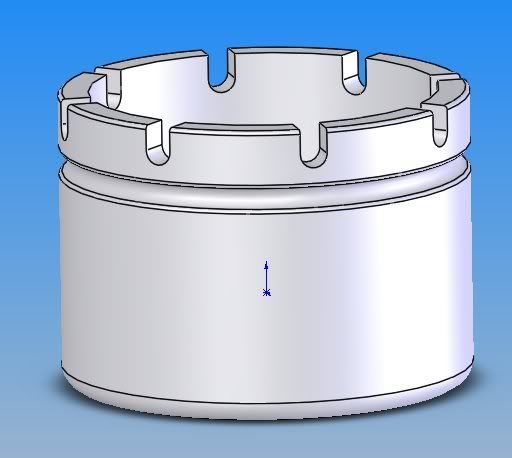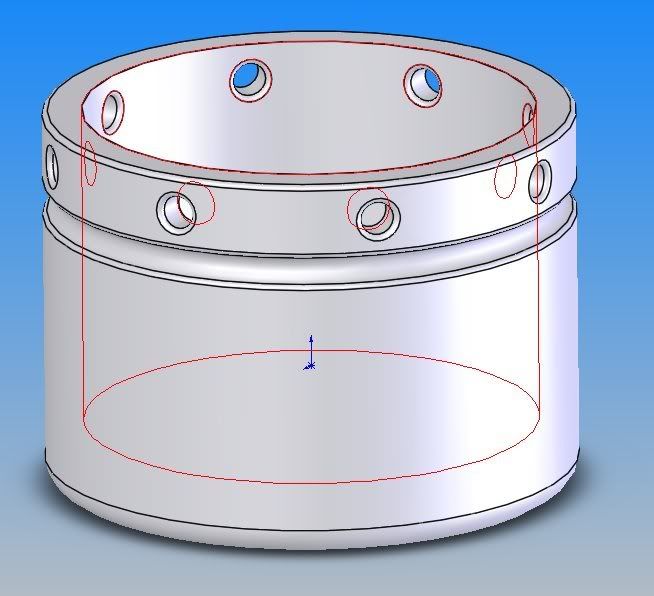|
| Site Partners: | SpotterGuides | Veloce Books |
| Related Sites: | Your Link Here |
|
||||||||||
|
||||||||||
|
|
#1 | |
|
Rookie
Join Date: Mar 2008
Posts: 21
 |
Material with the worst heat transmission?
Hi again, another stupid question from a non-engineer.
 Might anyone be able to tell me which material of the following has the worst heat transmission and is the best for a thermal barrier between parts in contact? The material will be of thickness no less than 3mm, and needs to insulate against some pretty high temps. Might anyone be able to tell me which material of the following has the worst heat transmission and is the best for a thermal barrier between parts in contact? The material will be of thickness no less than 3mm, and needs to insulate against some pretty high temps.
Thanks again! 
|
|
|
|

|
|
|
#2 | |
|
Racer
Join Date: Oct 2006
Posts: 253
 |
See http://www.engineersedge.com/properties_of_metals.htm
You will be pleased to know that both Stainless Steel 304 (followed by closely S/S 430) are the least conductive of the materials you mention. Last edited by Zico; 17 Apr 2008 at 17:11. |
|
|
|

|
|
|
#3 | |
|
Racer
Join Date: Oct 2006
Posts: 253
 |
What sort of temps are you talking about.. and will thermal expansion figures also be relevant to your application?
|
|
|
|

|
|
|
#4 | ||
|
Veteran
Join Date: Jul 2006
Posts: 4,418
  |
Wrap your item in gold foil. Great heat insulator.
Worst is anything Chromed. |
||
|
|
__________________
"When the fear of death out weighs the thrill of speed, brake." LG 
|
|
|
#5 | ||
 Race Official Race OfficialVeteran
Join Date: May 2003
Posts: 11,143
       |
AU N EGL, wrapping the part in anything isn't going to stop transmitted heat. I think the OP wants a good insulating type of gasket or barrier, or have I read it wrong.
|
||
|
|

|
|
|
#6 | ||
|
Veteran
Join Date: Jul 2006
Posts: 4,418
  |
|||
|
|
__________________
"When the fear of death out weighs the thrill of speed, brake." LG 
|
|
|
#7 | |
|
Veteran
Join Date: Nov 2005
Posts: 2,714
 |
He has asked for an insulator between parts in contact.
|
|
|
|

|
|
|
#8 | ||
 Race Official Race OfficialVeteran
Join Date: May 2004
Posts: 2,479
    |
I believe the answer to the original question was answered by the the original response by Zico.
For those who couldn't be bothered to follow his link, the thermal conductivities of the requested materials are as follows: Stainless steel : 8.09-8.11 Btu/hr.ft.degf Mild Steel : 26-37.5 Btu/hr.ft.degf Aluminium : 136 Btu/hr.ft.degf Titanium : 12.65 Btu/hr.ft.degf Obviously the material with the lowest conductivity provides the best thermal insulation against conducted (in contact) heat. That leaves the limiting factor of flex... which could mean he wants resistance to it or ability to withstand it... so anyone got a link to a table of modulus of elasticity for these materials? Last edited by dtype38; 17 Apr 2008 at 20:17. |
||
|
|

|
|
|
#9 | |
|
Racer
Join Date: Oct 2006
Posts: 253
 |
Sure.. Modulus of Elasticity in graph form.. http://www.engineeringtoolbox.com/yo...lus-d_773.html
And data.. http://www.postdiluvian.org/~mason/m...lasticity.html Everthing you need to know about S/S http://www.stainless-steel-world.net/pdf/11021.pdf and in Laymens terms.. Stainless steel grades

|
|
|
|

|
|
|
#10 | |||
|
Veteran
Join Date: Dec 2002
Posts: 3,364
    |
Quote:
Regards Jim |
|||
|
|
__________________
Life is not safe, just choose where you want to take the risks. 
|
|
|
#11 | ||
|
Rookie
Join Date: Mar 2008
Posts: 21
 |
Thanks for all the replies gents!
 Quote:
|
||
|
|

|
|
|
#12 | ||
|
Veteran
Join Date: Apr 2006
Posts: 1,943
 |
Are Ceramics definatly out of the question?
THe best insulators are ceramic, but they are brittle. That said if it is in a sandwich you may be better served. |
||
|
|
__________________
Contrary to popular opinion, I do have mechanical sympathy, I always feel sorry for the cars I drive. 
|
|
|
#13 | ||
 Race Official Race OfficialVeteran
Join Date: May 2004
Posts: 2,479
    |
Or make the item in Stainless Steel and have it ceramic coated like an exhaust manifold?
|
||
|
|

|
|
|
#14 | ||
|
Veteran
Join Date: Sep 2003
Posts: 1,074
  |
"Flex is a major concern since it will be used in an extreme high pressure design scenario."
The best insulator in general is - nothing! A vacuum, or a gas. Would a honeycomb composite be out of contention? JOhn |
||
|
|

|
|
|
#15 | |
|
Rookie
Join Date: Mar 2008
Posts: 21
 |
Well, what I intend to do is to sandwich a thermal barrier between the pad and the caliper in my brakes. The Brembo's on my setup have gone from red to black, and the caliper is showing signs of increased heat on the near side. not good when that's the same side that the brake line's attached to. Thus far they've gotten hot enough to fade 900-degree pads in just three laps(sprints) because of that I've very limited flying laps out of five at the very best, with the rest being used to cool the brakes down.
Thus, a honeycomb is definitely out as it will probably collapse the moment (if) any of the walls fail. And yes, I have brake ducts(they're the crappy Japanese ones though, am building up new stuff as we speak) |
|
|
|

|
|
|
#16 | ||
|
Veteran
Join Date: Dec 2005
Posts: 1,164
  |
Perhaps you should seriously consider CFRC brake discs and pads with large ducts, ala F1?
If you have 'faded' 900°C pads, then insulating them won't make matters better because the pads will fade earlier. Ultimately you need to increase the thermal capacity of your brake system (bigger, wider discs), so that over the course of a sprint they either absorb the heat or can get rid of more of it on the straights. What do the really quick people on the sprints do with brakes? Might it not be best to copy their setup a bit? |
||
|
|
__________________
Dallara F307 Toyota, MSV F3 Cup - Class and Team Champion 2012 Monoposto Champion 2008, 2010 & 2011. 
|
|
|
#17 | ||
|
Veteran
Join Date: Sep 2003
Posts: 1,074
  |
Ah, So!
Even I would have discounted a honeycomb composite there. My solutions in order of expence: 1/ better air flow to brakes. Air is cheap! 2/ water cooling. A water jet into the inner air intake of your vented disk. Not a big one, a windscreen washer jet is enough, and a small electric pump to drive them. This is ideal for a sprint car as the water supply will be limited. You can arrange a switch to turn on the pump when you apply the brakes - a feed from the brake lights would do, as such a small pump doesn't need much current. You don't need a lot of water as the latent heat of evaporation of water is enormous, much greater than that of exotic liquids - see the Wiki http://en.wikipedia.org/wiki/Latent_heat - and you don't want to squirt so much as to rapidly cool and crack the disks, just remove a lot of heat as steam. 3/ Recirculated brake fluid. This uses the whole volume of the brake fluid in pipes and master cylinder as a heat sink - again useful for sprints, but less so for endurance racing, where it can only radiate from the pipes, unless there is a seperate heat exchanger. John |
||
|
|

|
|
|
#18 | |||
|
Racer
Join Date: Feb 2005
Posts: 162
 |
Quote:
If it is a fluid boiling issue then make sure your caliper pistons are steel / stainless or titanium under no circumsances should you use aluminium as it just conducts your pad heat directly into the brake fluid. Another thing to do is remove the pistons from the caliper and machine the ends with a 'castle' shape. This does two things - firstly reduces the thermal 'path' to the fluid and secondly lets some air circulate in this critical area. You should obviously also use a high quality racing brake fluid ( e.g. AP 600 ) rather than normal road car fluid. Another thing about insulators, no matter how good they are they sill need to have a finite thickness to make any difference. Simply spraying on a super whizz-band cermaic coating that is only a few microns thick only works in the world of snake oil salesman not in a world where normal physics applies. |
|||
|
|

|
|
|
#19 | ||
|
Rookie
Join Date: Mar 2008
Posts: 21
 |
Quote:
I have checked the caliper pistons and can confirm that they are steel. On the weekend I had to manage the brakes to get at least two flying laps in a session. Neither fluid boil or pad fade were apparent(thanks to sessions being longer, and I could have two cooling laps in addition to the cool down) I'm beginning to think that the problem here lies with me and not the mechanical parts(done a couple of events since the OP) However, concerning machining the piston, I've managed to have a close look at a Superkart this week and noticed that the calipers in it are drilled out. Would you gentlemen recommend the "castle" idea or simply having reliefs put in as in image 2: Image 1: Castle  Image 2: Relief 
|
||
|
|

|
|
|
#20 | ||
|
Veteran
Join Date: Dec 2005
Posts: 1,164
  |
Fading brakes in two laps? When I sprinted out little F3 car with my brother the brakes were barely coming into the zone by the end of our back-to-back runs (with driving change cooling period in between admittedly).
The castle reduces the materal available for conduction. The relief idea won't make any difference other than lightening the pistons by about a gram. Castles or nothing (with radii on the base of the castellations [spelling]). |
||
|
|
__________________
Dallara F307 Toyota, MSV F3 Cup - Class and Team Champion 2012 Monoposto Champion 2008, 2010 & 2011. 
|
 |
|
|
 Similar Threads
Similar Threads
|
||||
| Thread | Thread Starter | Forum | Replies | Last Post |
| Mold Material | NWH | Racing Technology | 6 | 11 Jun 2005 13:22 |
| transmission | zefarelly | Racing Technology | 20 | 15 Sep 2004 07:59 |
| Reading Material | Nomad | ChampCar World Series | 2 | 8 Mar 2003 12:27 |
| New transmission | dedieux | Racing Technology | 13 | 24 Sep 2001 19:06 |